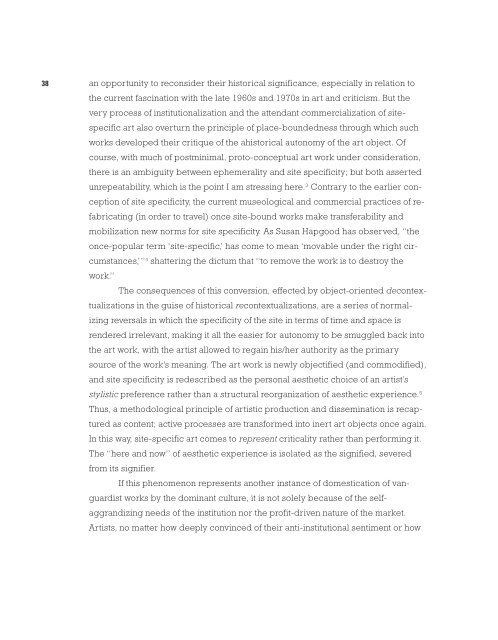ONE PLACE AFTER ANOTHER - Monoskop
ONE PLACE AFTER ANOTHER - Monoskop
ONE PLACE AFTER ANOTHER - Monoskop
You also want an ePaper? Increase the reach of your titles
YUMPU automatically turns print PDFs into web optimized ePapers that Google loves.
38<br />
an opportunity to reconsider their historical significance, especially in relation to<br />
the current fascination with the late 1960s and 1970s in art and criticism. But the<br />
very process of institutionalization and the attendant commercialization of sitespecific<br />
art also overturn the principle of place-boundedness through which such<br />
works developed their critique of the ahistorical autonomy of the art object. Of<br />
course, with much of postminimal, proto-conceptual art work under consideration,<br />
there is an ambiguity between ephemerality and site specificity; but both asserted<br />
unrepeatability, which is the point I am stressing here. 3 Contrary to the earlier conception<br />
of site specificity, the current museological and commercial practices of refabricating<br />
(in order to travel) once site-bound works make transferability and<br />
mobilization new norms for site specificity. As Susan Hapgood has observed, “the<br />
once-popular term ‘site-specific,’ has come to mean ‘movable under the right circumstances,’”<br />
4 shattering the dictum that “to remove the work is to destroy the<br />
work.”<br />
The consequences of this conversion, effected by object-oriented decontex-<br />
tualizations in the guise of historical recontextualizations, are a series of normal-<br />
izing reversals in which the specificity of the site in terms of time and space is<br />
rendered irrelevant, making it all the easier for autonomy to be smuggled back into<br />
the art work, with the artist allowed to regain his/her authority as the primary<br />
source of the work’s meaning. The art work is newly objectified (and commodified),<br />
and site specificity is redescribed as the personal aesthetic choice of an artist’s<br />
stylistic preference rather than a structural reorganization of aesthetic experience. 5<br />
Thus, a methodological principle of artistic production and dissemination is recaptured<br />
as content; active processes are transformed into inert art objects once again.<br />
In this way, site-specific art comes to represent criticality rather than performing it.<br />
The “here and now” of aesthetic experience is isolated as the signified, severed<br />
from its signifier.<br />
If this phenomenon represents another instance of domestication of van-<br />
guardist works by the dominant culture, it is not solely because of the selfaggrandizing<br />
needs of the institution nor the profit-driven nature of the market.<br />
Artists, no matter how deeply convinced of their anti-institutional sentiment or how

















